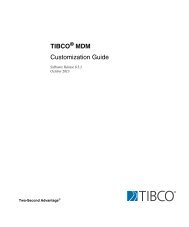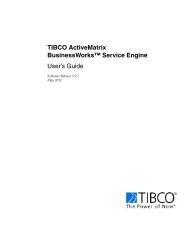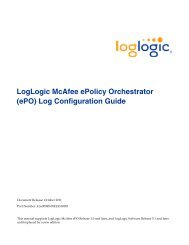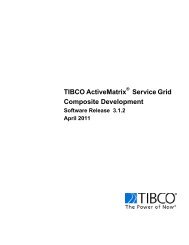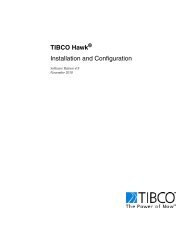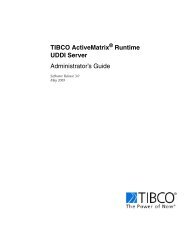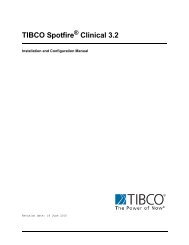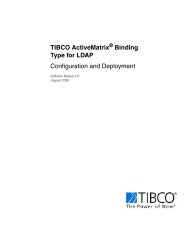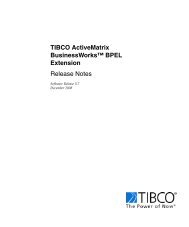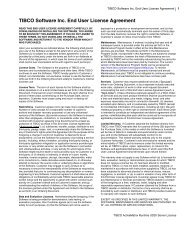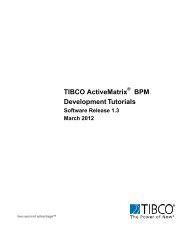TIBCO Spotfire Server 3.2.2 - TIBCO Product Documentation
TIBCO Spotfire Server 3.2.2 - TIBCO Product Documentation
TIBCO Spotfire Server 3.2.2 - TIBCO Product Documentation
Create successful ePaper yourself
Turn your PDF publications into a flip-book with our unique Google optimized e-Paper software.
Advanced Procedures<br />
<br />
For the <strong>TIBCO</strong> <strong>Spotfire</strong> <strong>Server</strong> cluster this is specified in the Allowed Users field(s).<br />
You can add as many users as you like. If you do not specify any users, then any<br />
authenticated user can issue impersonate calls. The most common use is to specify the<br />
same user as previously configured on the <strong>TIBCO</strong> <strong>Spotfire</strong> Web Player server. See the<br />
"<strong>TIBCO</strong> <strong>Spotfire</strong> Web Player - Installation and Configuration Manual" for more<br />
information.<br />
Specific requirements can also be made on the origin of an impersonate call. Typically,<br />
you would want to configure the <strong>TIBCO</strong> <strong>Spotfire</strong> <strong>Server</strong> cluster to only allow<br />
impersonation calls originating from the machines running a trusted <strong>TIBCO</strong> <strong>Spotfire</strong><br />
Web Player server.<br />
If one or more servers are listed in the Web Player <strong>Server</strong> field(s), then only calls<br />
originating from these machines are allowed. Allowed machines can be specified in<br />
two ways: originating IP number or originating name. The originating IP number<br />
should be the IP number of the machine, and a specified originating name is resolved<br />
to one (or more) IP numbers using DNS. Only calls originating from one of the<br />
mentioned machines are valid for impersonation. If no information is provided in the<br />
Web Player <strong>Server</strong> field, then calls originating from any machine are valid for<br />
impersonation.<br />
To enable impersonation:<br />
1 Start the <strong>TIBCO</strong> <strong>Spotfire</strong> Configuration Console.<br />
2 Go to the Impersonation tab.<br />
3 Click the Edit button in the toolbar.<br />
Comment: You will be prompted to stop the entire cluster.<br />
Response: The Enable Impersonation drop-down list will become active.<br />
4 Click on the Enable Impersonation drop-down, and select Yes.<br />
Response: The impersonation settings become editable.<br />
5 Select whether you want to require the impersonation call to be made on https by<br />
checking the Require SSL option. If you leave it blank both http and https are<br />
allowed. If you select https then you must make sure both the <strong>TIBCO</strong> <strong>Spotfire</strong> <strong>Server</strong><br />
and the <strong>TIBCO</strong> <strong>Spotfire</strong> Web Player server can communicate using https.<br />
6 Specify whether only certain users should be able to issue impersonation calls by<br />
entering those user names in the Allowed Users field. Only enter one user per row.<br />
Click the plus sign next to the field to add another row where you can specify an<br />
additional user.<br />
7 Specify whether the <strong>TIBCO</strong> <strong>Spotfire</strong> <strong>Server</strong> cluster should only accept impersonation<br />
calls from certain machines. If you want to limit impersonation calls in this way,<br />
specify the originating machine by entering the IP numer or host name in the Web<br />
Player <strong>Server</strong>s field. Only enter one machine per row. Click the plus sign next to the<br />
field to add another row where you can specify an additional machine.<br />
8 Click the Done button in the toolbar.<br />
126 (144) <strong>TIBCO</strong> <strong>Spotfire</strong>® <strong>Server</strong> <strong>3.2.2</strong>



